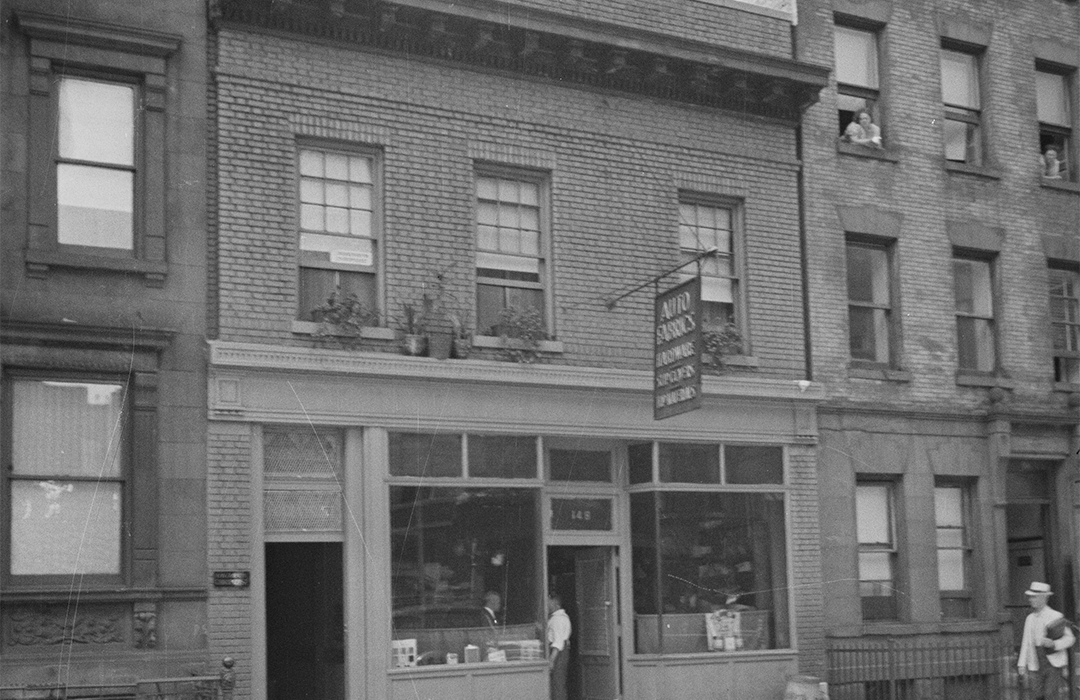
148 West 62nd Street
by Tom Miller
In the decade following the end of the Civil War, the first tentative stages of the transformation of the Upper West Side from farms and country homes to a bustling neighborhood of homes, churches, and stores began. Around 1875, a two-story structure was erected at 148 West 62nd Street between Ninth and Tenth Avenues. It most likely always had a store on the ground floor with residential space on the second.
The property was owned by police sergeant William J. Linden and his wife, Loretta (who was known as Ellen), by the early 1890s. Linden worked far downtown in the Third Precinct near City Hall. He died in the West 62nd Street house on June 19, 1895. Three days later, his funeral was held in the Church of St. Paul the Apostle nearby on 60th Street and Columbus Avenue.
In June 1902, Ellen T. Linden leased the ground floor to the Excelsior Brewing Company of Brooklyn for four years. At the time, it was common for breweries to run their own saloons, thereby ensuring that the only alcohol sold was their own. It seems at the same time Ellen Linden moved to West 72nd Street and leased the upper floor to Irish-born roomers.
At the time, it was common for breweries to run their own saloons…
Living above the saloon (named McNally’s Café) by 1905 was a Mrs. Braden. In January 1906, she received a license from the city “to board children.” Most likely she ran what today would be called a small day care. It would have enabled St. Juan Hill mothers to work and not worry about their children.
One resident in 1909 had an easy commute to work–he was a bartender in the saloon downstairs. But, unfortunately, he was let go that year. On September 11, an advertisement appeared in the New York Herald that read, “Bartender—Saloon keeper wishes to secure position for honest, sober young Irishman, for whom he regrets he has no further employment; good worker. McNally’s Café, 148 West 62d.”
Ten days later, after apparently little response, the man placed his own ad touting his strengths. “Bartender, absolutely honest, sober young Irishman, thoroughly experienced, good mixer, neat, fast worker; hotel, café; references.”
In August 1913, Ellen T. Linden hired architect Henry A. Koelble to update the building. He gave the façade a modern Arts & Crafts design, with a Flemish bond brick veneer, a parapet above the original bracketed cornice, and a trim wooden storefront. The alterations cost Ellen Linden $9,000—the equivalent of a quarter of a million in 2024 dollars.
What had been McNally’s Café became Tuam Hall, another Irish saloon and meeting place operated by Quinn and Mahoney. An advertisement in the Irish American Advocate in February 1915 promised, “Can be had free for Weddings, Benefits, Social Dances and Meetings,” and touted, “Convenient to all Elevated, Subway and Street Cars.” The ad noted, “Dancing every Saturday and Wednesday Evenings.”
A most unexpected change came in the spring of 1918. On April 26, the New York Sun reported, “The Emanuel African M. E. Church has bought from the Excelsior Brewing Company the leasehold property at 148 West Sixty-second street, a two-story building…The lease has thirty-five years to run, the fee being owned by Mrs. Loretta Linden. After extensive alterations, the property will be used for church purposes.”
Unfortunately for the Emanuel African Methodist Episcopal Church, the storefront church in the seamy neighborhood did not survive.
Unfortunately for the Emanuel African Methodist Episcopal Church, the storefront church in the seamy neighborhood did not survive. Ellen T. Linden had died before May 1925 when her estate leased the building to J. C. Alves. His venture, too, was short lived.
On May 21, 1925, The Sun reported, “The Linden estate sold the two story business building 148 West Sixty-second street to a Mr. Goldberger, who will occupy it for automobile accessories.” The I. Goldberger auto shop fared much better than its predecessors, lasting until 1942. That year, in June, the George Ponser Company moved in. The Newark, New Jersey-based firm dealt in pinball and other coin-operated machines and had branches in several states.
The George Ponser Company’s lease was ill-timed. Five years later, the City of New York targeted the San Juan Hill district for redevelopment. In 1947, the first building was demolished that would eventually result in a two-block campus—from 60th to 62nd Street and Columbus to Amsterdam Avenues–for the Fordham College at Lincoln Center.
Tom Miller is a social historian and blogger at daytoninmanhattan.blogspot.com


